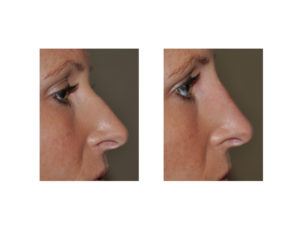The use of injectable fillers in the face has expanded tremendously over the past decade. What was once viewed as off limits to place fillers has now become commonplace. This is particularly relevant to the nose whose small and tight tissues was historically felt to be an ill advised place for injecting fillers.

In the May 2017 issue of the journal Plastic and Reconstructive Surgery a paper was published entitled ‘Facial Danger Zones: Techniques to Maximize Safety during Soft Tissue Filler Injections’. In this well written paper the authors discuss their preferred injection techniques based on the facial dangers zones (key locations of arteries and veins) to minimize the risks of vascular complications…which can be catastrophic.
One area of relevance from this paper to this post is that of the nose. For treating the nose, they advocate injecting deep down at the periosteum and perichondrium level. This is because the blood supply to the soft tissues of the nose its very superficial and runs just under the skin. Deep injections avoids injuring and inadvertently infusing the vessels. When injecting compression of the dorsal nasal and angular arteries should be done as well. The nose should be injected serially with 10 to 15 minutes between each injections with massaging of the nose between each serial injection. For the nasal tip and ala, serial punctures with very small volumes should be done to inadvertently making a bulbous tip.
The one exclusion for nasal injections is in the previous rhinoplasty patient, particularly one that has implants or grafts on the dorsal of the nose. Scar tissue and the distortion of the tissue planes makes the risk of vascular compromise much higher.
Dr. Barry Eppley
Indianapolis, Indiana


